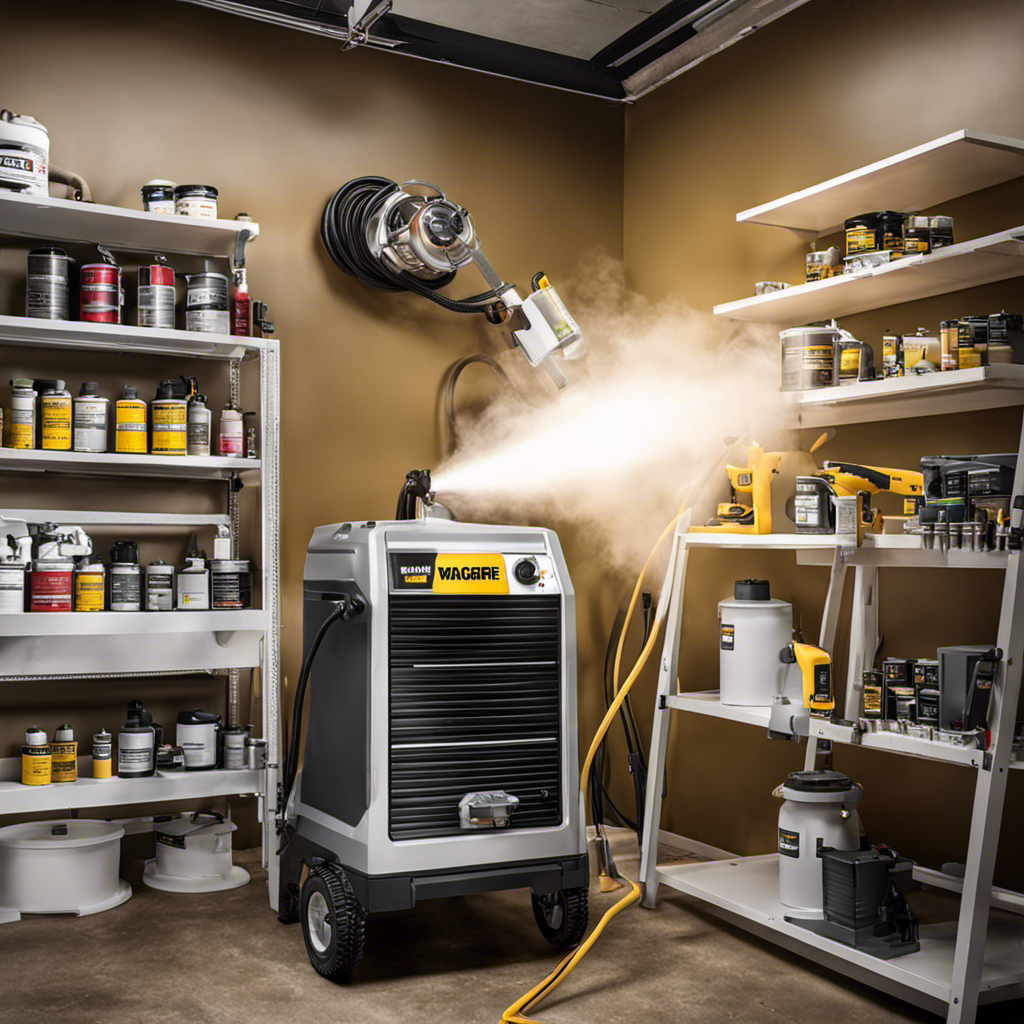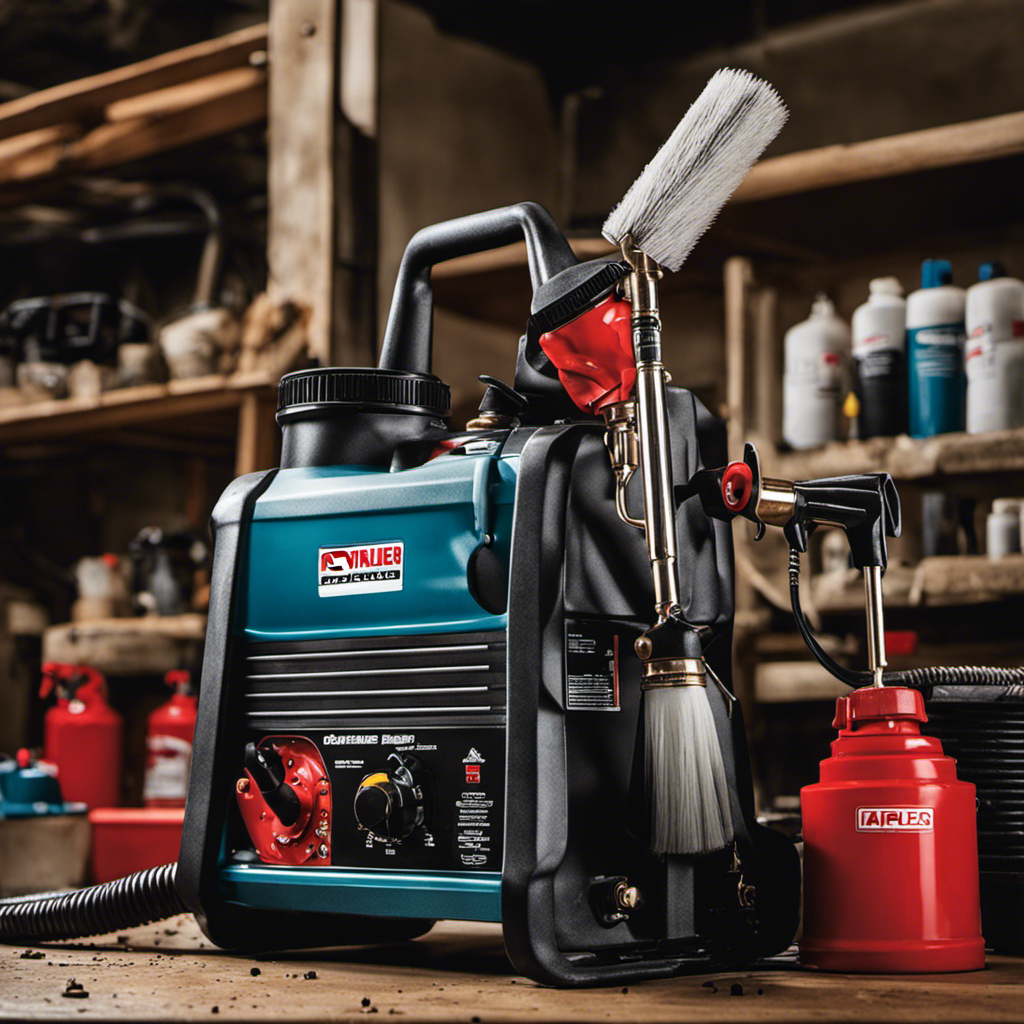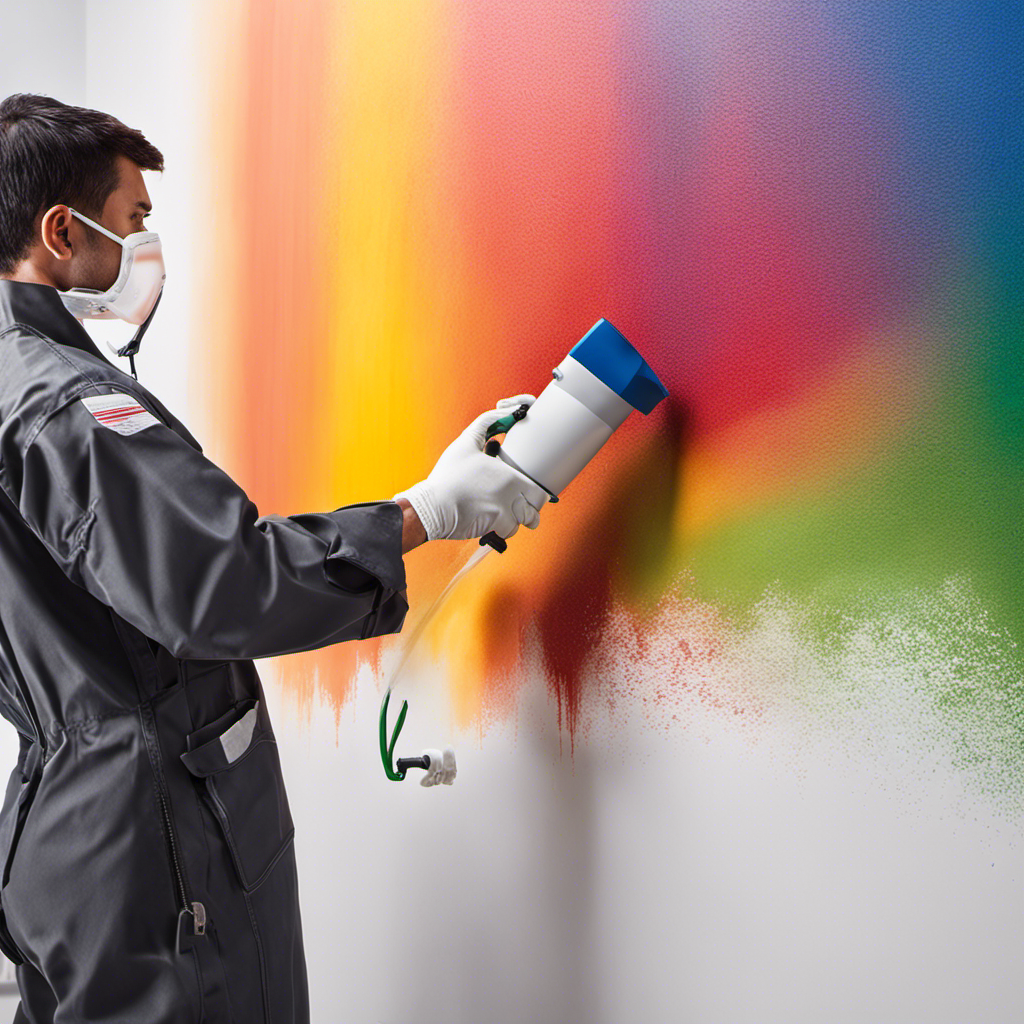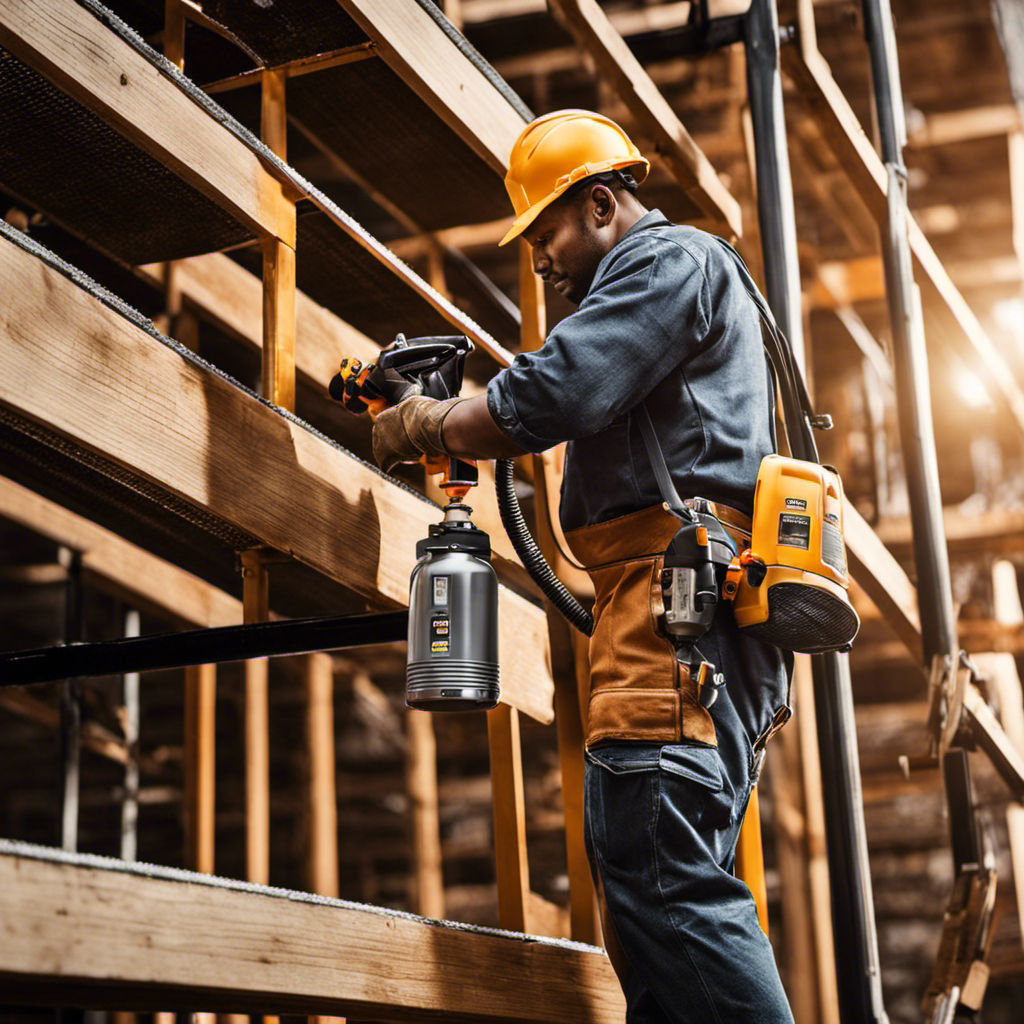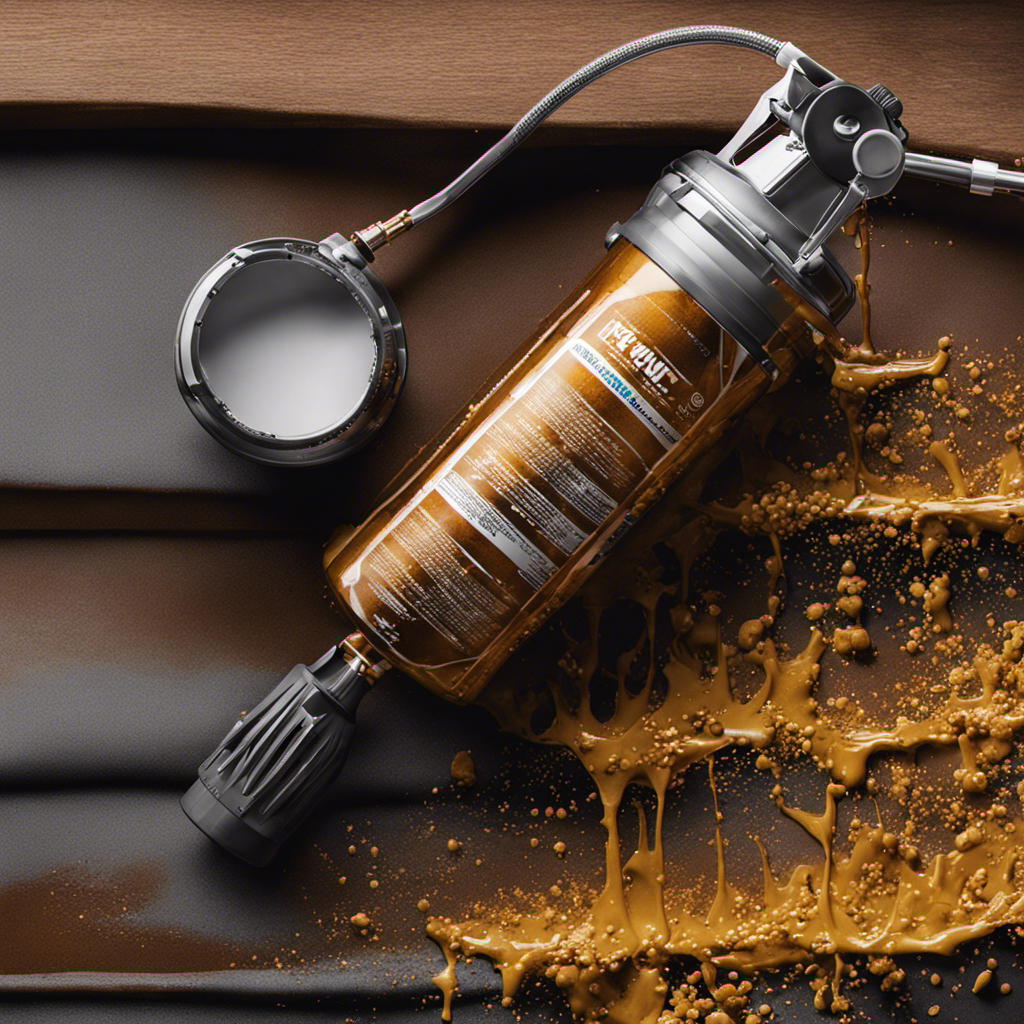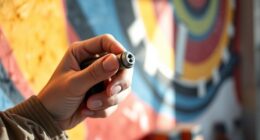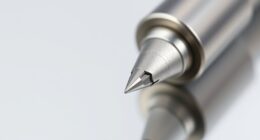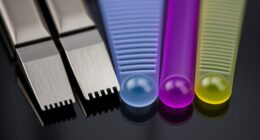Getting a Wagner Airless Paint Sprayer ready for use is essential in order to achieve a flawless, professional finish. With its strong motor and user-friendly setup, this sprayer is a top pick for both DIYers and seasoned painters.
By properly priming the sprayer, users can ensure that the paint flows smoothly through the system, preventing clogs and ensuring an even coat. In this article, we will explore the components and preparation process, as well as troubleshooting tips to help you achieve perfect results every time.
Key Takeaways
- Motor powers the piston pump
- Choose the right paint for priming
- Thoroughly clean and prepare the surface
- Adjust the pressure settings for optimal coverage
Understanding the Components and Preparation
The user should choose the right type and color of paint and measure and mix it according to instructions to properly prepare the Wagner airless paint sprayer for priming.
Choosing the right paint type is crucial for achieving the desired results. Different surfaces require different types of paint, such as latex or oil-based.
Understanding surface preparation is also important for successful priming. The surface should be clean, dry, and free from any loose or flaking paint. It may be necessary to sand or scrape the surface to create a smooth and even base.
Additionally, any holes or cracks should be filled and repaired before priming. Properly preparing the surface ensures that the paint adheres well and provides a long-lasting finish.
Choosing the Right Paint for Priming
When choosing the right paint for priming, it is important to consider the type of surface being painted. Different surfaces require different types of paint to ensure proper adhesion and a smooth finish. Here are some tips and tricks for achieving a smooth primed surface:
-
Choose the right type of paint for the surface: Whether it’s wood, metal, or drywall, there are specific types of primers that are designed to adhere to each surface. Make sure to select the appropriate primer for the job.
-
Consider the condition of the surface: If the surface has stains or is heavily damaged, it may require a stain-blocking or high-build primer. These primers are designed to cover imperfections and create a smooth base for the topcoat.
-
Follow the manufacturer’s instructions: Different primers have different application methods and drying times. It’s important to read and follow the instructions on the paint can to ensure optimal results.
Considering the Type of Surface
To achieve a smooth and professional-looking finish, it’s important for the user to consider the type of surface being painted before selecting the appropriate primer.
Different surfaces require different types of primer to ensure proper adhesion and durability of the paint.
When applying primer on different surfaces, it’s crucial to troubleshoot common surface-related issues to avoid any potential problems.
For example, when priming a smooth and non-porous surface like metal or glass, it’s important to use a primer specifically designed for these surfaces to promote adhesion.
On the other hand, when priming a porous surface like wood or drywall, it’s important to use a primer that seals the surface and prevents the paint from being absorbed unevenly.
Preparing the Paint for Priming
Users should prepare the paint for priming by measuring and mixing it according to instructions, as well as straining it to remove impurities. Proper preparation of the paint is essential to achieve a smooth and professional finish.
Here are some important considerations for preparing the paint:
-
Choosing the right paint type, color, and brand: Selecting the appropriate paint for the specific project and surface is crucial. Consider factors such as the type of surface, desired finish, and durability requirements. Additionally, choose a color that complements the overall design or theme.
-
Proper paint storage and shelf life: Ensure that the paint is stored in a cool and dry place to prevent it from deteriorating. Check the expiration date on the paint can and discard any expired or spoiled paint. It’s also important to mix the paint well before use to ensure consistent color and texture.
-
Straining the paint: Straining the paint before pouring it into the paint sprayer helps remove any impurities or debris that may affect the spray pattern or clog the nozzle. Use a fine mesh strainer or paint filter to strain the paint and ensure a smooth and even application.
Measuring and Mixing the Paint
Measuring and mixing the paint is a crucial step in the preparation process for achieving an optimal and consistent finish. To ensure proper paint consistency, it is important to follow the recommended paint mixing techniques.
Start by carefully measuring the paint according to the instructions provided by the manufacturer. Use a measuring cup or scale to accurately measure the desired amount of paint. Once the paint is measured, pour it into a clean mixing container.
Use a stir stick or a mechanical paint mixer to thoroughly mix the paint. This will help to evenly distribute any pigments and ensure a consistent color throughout. If the paint consistency is too thick or thin, troubleshoot by adding small amounts of water or paint thinner respectively.
Continuously stir and test the paint until the desired consistency is achieved. By following these paint mixing techniques and troubleshooting paint consistency issues, you can ensure a successful priming process and achieve the desired finish.
Straining the Paint to Remove Impurities
Straining the paint through a mesh strainer is an effective method for removing any impurities before priming. This step is crucial to ensure a smooth and even application of paint onto the surface.
Here’s why straining the paint is important:
-
Removing impurities: Paint can contain small particles, such as dust, dirt, or dried paint flakes, which can clog the sprayer nozzle and lead to an uneven finish. Straining the paint helps to filter out these impurities, preventing them from obstructing the spray gun and ensuring a clean flow of paint.
-
Preventing clogs: When paint is not strained, these impurities can cause clogs in the sprayer system, leading to interruptions in the paint flow or uneven spray patterns. By straining the paint, you eliminate the risk of clogs and maintain a consistent flow of paint throughout the priming process.
-
Achieving a professional result: Straining the paint allows for a smoother application, resulting in a more professional-looking finish. It helps to eliminate any lumps or clumps in the paint, ensuring that the sprayed surface has a uniform appearance.
Cleaning and Preparing the Surface
After straining the paint to remove impurities, the next step in priming a Wagner airless paint sprayer is cleaning and preparing the surface. Proper surface preparation is crucial to ensure the paint adheres well and provides a smooth finish.
To start, the surface should be thoroughly cleaned using appropriate cleaning techniques such as scrubbing with a mild detergent or using a pressure washer. This helps remove dirt, grease, and other contaminants that can affect the paint’s adhesion.
After cleaning, any loose or peeling paint should be scraped off and the surface should be sanded to create a smooth and even base. Additionally, any cracks or holes should be filled with appropriate patching material.
Lastly, the surface should be properly dried before proceeding with priming to prevent any moisture-related issues.
Using Primer for a Smooth Base
To achieve a smooth base, it’s important to use primer before applying paint with a Wagner airless paint sprayer. Choosing the right primer for a smooth base is crucial to ensure optimal adhesion and coverage.
Here are common issues with priming and their solutions:
-
Inadequate adhesion: If the primer doesn’t adhere properly to the surface, it can result in poor paint adhesion and peeling.
Solution: Make sure to clean and prepare the surface thoroughly before priming. Use a primer specifically designed for the type of surface you’re working on. -
Uneven coverage: Uneven primer coverage can lead to an uneven paint finish.
Solution: Apply the primer in thin, even coats, using overlapping strokes. Adjust the sprayer’s pressure and nozzle width to achieve consistent coverage. -
Drying issues: If the primer takes too long to dry or remains tacky, it can cause problems when applying the paint.
Solution: Ensure proper ventilation and temperature conditions for drying. Consider using a faster-drying primer or applying thinner coats.
Setting Up and Adjusting the Sprayer
The user needs to ensure that the sprayer is clean and free from debris before setting it up and adjusting it.
Before starting the setup process, it is important to inspect the sprayer for any dirt, dust, or obstructions that could affect its performance. Cleaning the sprayer thoroughly will help prevent any paint flow issues that may occur during priming.
Once the sprayer is clean, the user can proceed with attaching the spray gun and hose securely. It is essential to follow the manufacturer’s guidelines for proper attachment.
After that, the paint container should be filled with primer, and the sprayer should be plugged in and turned on. At this point, the user can adjust the nozzle width for the project and troubleshoot any leaks or connections.
Finally, the pressure settings should be set according to the manufacturer’s recommendations to ensure consistent pressure during priming.
Ensuring the Sprayer Is Clean and Free From Debris
After setting up and adjusting the sprayer, the next step in priming a Wagner airless paint sprayer is to ensure that the sprayer is clean and free from debris. This is crucial for maintaining consistent pressure and troubleshooting sprayer performance. Here are the steps to follow:
-
Inspect the sprayer for any dirt, dust, or paint residue. Clean the exterior of the sprayer using a soft cloth or brush.
-
Check the spray gun and hose for any clogs or blockages. Clear any obstructions using a small tool or brush.
-
Examine the pump and filter for any signs of clogs or blockages. Clean the filter thoroughly and ensure there are no obstructions.
Attaching the Spray Gun and Hose Securely
Attaching the spray gun and hose securely is a crucial step in using the Wagner airless paint sprayer. To ensure proper operation, it is important to troubleshoot any issues with the spray gun before priming.
If the spray gun is not functioning correctly, check for clogs or blockages in the nozzle. Clear any obstructions using a small tool or brush.
Additionally, adjusting the spray patterns for optimal coverage is essential. The spray patterns can be adjusted by changing the nozzle width or pressure settings on the sprayer. Experiment with different settings to find the best technique for your specific project.
Filling the Paint Container With Primer
To ensure proper operation, the user should securely attach the hose to the pump before filling the paint container with primer. This step is crucial to prevent any leaks or interruptions during the priming process.
Here are some techniques and tips for filling the paint container with primer:
-
Measure and mix the primer according to the manufacturer’s instructions. It’s important to follow the recommended ratios to achieve the desired consistency and coverage.
-
Strain the primer before pouring it into the paint container. This will help remove any impurities or clumps that could clog the spray gun or nozzle.
-
Fill the paint container with primer, making sure not to overfill it. Leave some space at the top to allow for proper mixing and agitation.
Plugging in and Turning on the Sprayer
The user plugs in the sprayer and turns it on to begin the priming process.
Plugging in the Wagner airless paint sprayer is a crucial step in preparing for priming. Once plugged in, the user can turn on the sprayer to start the priming process.
It is important to ensure that the sprayer is clean and free from debris before plugging it in. This helps to maintain the spray pressure and prevent any issues during priming.
If there are any leaks or connections that need to be checked, the user should troubleshoot and address them before starting the priming process.
Adjusting the Nozzle Width for the Project
Adjusting the nozzle width for the project allows the user to control the spray pattern and coverage when using a Wagner airless paint sprayer. This is an important step in achieving the desired results.
Here are some key points to consider when adjusting the nozzle width:
-
Choosing the appropriate nozzle size for different surfaces:
- Different surfaces require different nozzle sizes to achieve optimal coverage.
- Smaller nozzle sizes are suitable for detailed work and thin materials.
- Larger nozzle sizes are better for covering larger areas and thicker materials.
-
Troubleshooting common issues with nozzle clogging:
- Nozzle clogging can occur due to paint or debris build-up.
- To prevent clogging, strain the paint before using it in the sprayer.
- If clogging occurs, clean the nozzle with a cleaning solution or replace it if necessary.
Troubleshooting Leaks and Checking Connections
After adjusting the nozzle width for the project, the next step in priming a Wagner airless paint sprayer is troubleshooting leaks and checking connections. This is an important step to ensure that the sprayer functions properly and delivers paint without any issues.
To troubleshoot leaks, it is essential to inspect all connections and fittings for any signs of leakage. This includes checking the connections between the spray gun, high-pressure hose, and the sprayer itself. If any leaks are found, they should be addressed immediately by tightening the connections or replacing any damaged parts.
In addition to checking for leaks, it is also important to ensure that all connections are secure and tight. Loose connections can cause paint to leak or spray unevenly, affecting the overall priming process. By carefully inspecting and tightening all connections, users can ensure a smooth and efficient priming experience.
To help visualize the troubleshooting process, here is a table showcasing common leaks and connection issues that may arise when using a Wagner airless paint sprayer:
| Common Leaks | Connection Issues |
|---|---|
| Paint dripping from spray gun | Loose connection between spray gun and hose |
| Paint leaking from hose | Loose connection between hose and sprayer |
| Inconsistent spray pattern | Loose connection between pump and hose |
| Paint splattering during spraying | Damaged or worn-out fittings |
Frequently Asked Questions
Can I Use a Wagner Airless Paint Sprayer for Other Types of Paint Applications Besides Priming?
Using a Wagner airless paint sprayer for various paint applications besides priming offers several benefits. The sprayer allows for efficient and even coverage, saving time and effort.
It can be used with different types of paint, such as latex, acrylic, and enamel, providing versatility for different projects. The adjustable pressure settings and nozzle options allow for customization based on the desired finish.
Overall, a Wagner airless paint sprayer is a reliable tool for a range of paint applications.
What Should I Do if There Is a Blockage in the Hose or Spray Gun During Priming?
If there is a blockage in the hose or spray gun during priming, the user should follow these troubleshooting tips to unclog the Wagner airless paint sprayer.
First, turn off the sprayer and disconnect the hose from both the sprayer and the gun.
Then, inspect the hose for debris or obstructions and remove any using a brush or small tool.
Next, check the sprayer’s pump for blockages and clean the filter thoroughly.
If the issue persists, refer to the user manual or contact the manufacturer for further assistance.
How Often Should I Replace the Spray Tip on My Wagner Airless Paint Sprayer?
To ensure optimal performance, it’s recommended to regularly maintain and replace the spray tip on a Wagner airless paint sprayer. The spray tip is a crucial component that can wear out over time, leading to diminished spray quality and uneven coverage.
The recommended maintenance schedule for spray tip replacement varies depending on factors such as frequency of use and type of paint being sprayed. It’s advisable to consult the user manual or contact the manufacturer for specific guidelines on spray tip maintenance and replacement.
Is It Necessary to Wear Protective Gear While Priming With a Wagner Airless Paint Sprayer?
Wearing protective gear while priming with a Wagner airless paint sprayer is necessary to ensure safety and minimize potential risks.
It provides benefits such as protecting the user from inhaling paint fumes, preventing accidental contact with the skin or eyes, and reducing the risk of respiratory issues.
Alternatives to Wagner airless paint sprayers for priming purposes include traditional paintbrushes or rollers, but they may not provide the same level of efficiency and even coverage.
How Do I Properly Clean and Maintain My Wagner Airless Paint Sprayer After Priming?
To properly clean and maintain a Wagner airless paint sprayer after priming, it’s important to follow proper cleaning techniques and adhere to a recommended maintenance schedule.
After priming, the sprayer should be flushed with clean water to remove any paint residue.
A soft-bristle brush can be used to scrub stubborn spots, and a cleaning solution recommended by Wagner can be applied if necessary.
The sprayer should then be wiped with a clean cloth, lubricated, and stored properly to ensure its longevity and optimal performance.
Conclusion
In conclusion, priming a Wagner Airless Paint Sprayer requires a thorough understanding of its components and preparation process. By choosing the right paint and properly preparing the surface, users can achieve optimal results.
Troubleshooting and maintenance are crucial to ensure the sprayer’s efficiency and longevity.
However, have you ever wondered how priming with a Wagner Airless Paint Sprayer can transform your painting experience? With its advanced technology and user-friendly design, this sprayer allows for precise and efficient priming, saving you time and effort.
Drenched in creativity and armed with a fountain pen, Isolde weaves words as gracefully as a painter strokes their canvas. A writer for Paint Sprayer Zone, her passion for colors, textures, and spaces finds a harmonious blend with her profound knowledge of painting tools and techniques.
Having grown up in a family of artists, Isolde’s tryst with paints began early. While her relatives expressed themselves on canvas, Isolde found her medium in words. She dedicated herself to chronicling the world of painting, understanding the nuances of each tool, and the artistry behind every spritz of a paint sprayer.
